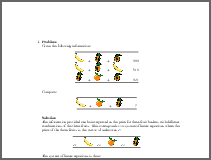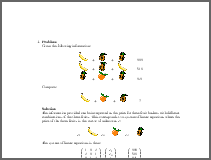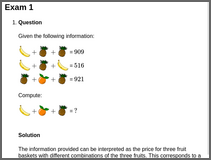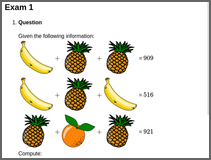fruit: Image-Based Systems of Linear Equations (Numeric)
fruitGiven the following information:
| \(+\) | \(+\) | = | \(909\) | |||
| \(+\) | \(+\) | = | \(516\) | |||
| \(+\) | \(+\) | = | \(921\) |
Compute:
| \(+\) | \(+\) | = | \(\text{?}\) |
The information provided can be interpreted as the price for three fruit baskets with different combinations of the three fruits. This corresponds to a system of linear equations where the price of the three fruits is the vector of unknowns \(x\):
| \(x_1 =\) | \(x_2 =\) | \(x_3 =\) |
The system of linear equations is then: \[ \begin{aligned} \left( \begin{array}{rrr} 1 & 0 & 2 \\ 2 & 0 & 1 \\ 0 & 1 & 2 \end{array} \right) \cdot \left( \begin{array}{r} x_1 \\ x_2 \\ x_3 \end{array} \right) & = & \left( \begin{array}{r} 909 \\ 516 \\ 921 \end{array} \right) \end{aligned} \] This can be solved using any solution algorithm, e.g., elimination: \[ x_1 = 41, \, x_2 = 53, \, x_3 = 434. \] Based on the three prices for the different fruits it is straightforward to compute the total price of the fourth fruit basket via:
| \(+\) | \(+\) | = | ||||
| \(x_1\) | \(+\) | \(x_2\) | \(+\) | \(x_3\) | = | |
| \(41\) | \(+\) | \(53\) | \(+\) | \(434\) | = | \(528\) |
Given the following information:
| \(+\) | \(+\) | = | \(549\) | |||
| \(+\) | \(+\) | = | \(140\) | |||
| \(+\) | \(+\) | = | \(620\) |
Compute:
| \(+\) | \(+\) | = | \(\text{?}\) |
The information provided can be interpreted as the price for three fruit baskets with different combinations of the three fruits. This corresponds to a system of linear equations where the price of the three fruits is the vector of unknowns \(x\):
| \(x_1 =\) | \(x_2 =\) | \(x_3 =\) |
The system of linear equations is then: \[ \begin{aligned} \left( \begin{array}{rrr} 0 & 1 & 2 \\ 1 & 2 & 0 \\ 1 & 0 & 2 \end{array} \right) \cdot \left( \begin{array}{r} x_1 \\ x_2 \\ x_3 \end{array} \right) & = & \left( \begin{array}{r} 549 \\ 140 \\ 620 \end{array} \right) \end{aligned} \] This can be solved using any solution algorithm, e.g., elimination: \[ x_1 = 94, \, x_2 = 23, \, x_3 = 263. \] Based on the three prices for the different fruits it is straightforward to compute the total price of the fourth fruit basket via:
| \(+\) | \(+\) | = | ||||
| \(x_1\) | \(+\) | \(x_2\) | \(+\) | \(x_3\) | = | |
| \(94\) | \(+\) | \(23\) | \(+\) | \(263\) | = | \(380\) |
Given the following information:
| \(+\) | \(+\) | = | \(780\) | |||
| \(+\) | \(+\) | = | \(133\) | |||
| \(+\) | \(+\) | = | \(188\) |
Compute:
| \(+\) | \(+\) | = | \(\text{?}\) |
The information provided can be interpreted as the price for three fruit baskets with different combinations of the three fruits. This corresponds to a system of linear equations where the price of the three fruits is the vector of unknowns \(x\):
| \(x_1 =\) | \(x_2 =\) | \(x_3 =\) |
The system of linear equations is then: \[ \begin{aligned} \left( \begin{array}{rrr} 1 & 0 & 2 \\ 2 & 1 & 0 \\ 1 & 2 & 0 \end{array} \right) \cdot \left( \begin{array}{r} x_1 \\ x_2 \\ x_3 \end{array} \right) & = & \left( \begin{array}{r} 780 \\ 133 \\ 188 \end{array} \right) \end{aligned} \] This can be solved using any solution algorithm, e.g., elimination: \[ x_1 = 26, \, x_2 = 81, \, x_3 = 377. \] Based on the three prices for the different fruits it is straightforward to compute the total price of the fourth fruit basket via:
| \(+\) | \(+\) | = | ||||
| \(x_1\) | \(+\) | \(x_2\) | \(+\) | \(x_3\) | = | |
| \(26\) | \(+\) | \(81\) | \(+\) | \(377\) | = | \(484\) |
(Note that the HTML output contains mathematical equations in MathML, rendered by MathJax using ‘mathjax = TRUE’. Instead it is also possible to use ‘converter = “pandoc-mathjax”’ so that LaTeX equations are rendered by MathJax directly.)
Demo code:
library("exams")
set.seed(403)
exams2html("fruit.Rmd", mathjax = TRUE)
set.seed(403)
exams2pdf("fruit.Rmd")
set.seed(403)
exams2html("fruit.Rnw", mathjax = TRUE)
set.seed(403)
exams2pdf("fruit.Rnw")


